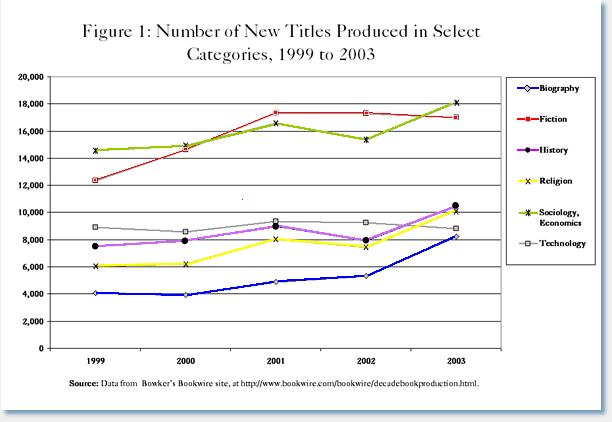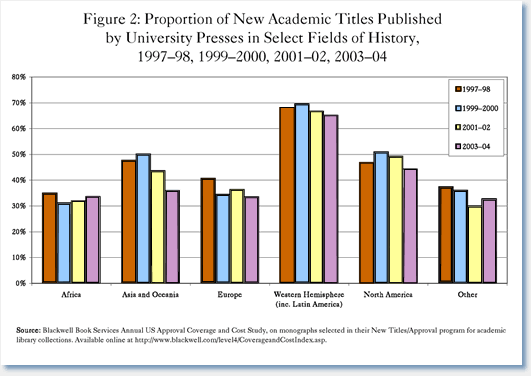News
Publishing in 2003: One for the History Books?
History books are among the subjects leading a surge in book publishing over the past year, but the evidence for monographs and books produced by professional historians is mixed.
In an analysis based upon its massive Books in Print database, R.R. Bowker Company reported that the number of new history titles published grew by almost one-third between 2002 and 2003, from 7,929 to 10,439.1
This marked a significant recovery from the sharp decline reported between 2001 and 2002, when the number of new history titles fell 12.2 percent, from a high of 9,028. As we noted in a report on scholarly publishing last October, the field slipped along with most of the publishing industry in the post-September 11 recession.2
Viewed in comparison to the other broad categories Bowker surveyed, history is the largest category of published works after adult and juvenile fiction, and a combined category of "sociology and economics." History titles comprised 6.3 percent of the new works published.
According to the Bowker analysis, the number of history titles produced has grown 60.3 percent since 1993. This is about average for growth in new book production over that period, lagging well behind subjects like biography (up 132 percent since 1993) and religion (up 116 percent). Nevertheless, even set against the rapid growth in those categories, the number of history books produced last year is significantly large.
Of course, what this fails to tell us is how many of those history titles were written by professional historians. One significant indicator in the Bowker report is troubling—the number of history titles produced by university presses fell 8.3 percent from the year before. This decline was larger than the overall drop of 2.2 percent among all new university press titles.
Despite (or perhaps because of) the drop in the number of new titles published, university presses did report a modest improvement in sales. According to Peter Givler, executive director of the American Association of University Professors, last year "saw a modest improvement in book sales overall for university presses as they’re catching the breeze—one hates to call it a wind—from the economic recovery." But the pressure on scholarly books continues. Robert Darnton of Princeton University, a historian of books and past president of the AHA, agreed that this remains a vital area of concern for the discipline. "Publishers are like farmers: they always complain about their latest crop," Darnton said. "But even after allowing for the usual jeremiads, it must be admitted that sales of serious books, especially university-press books, have been bad over the last decade. Any upturn is to be welcomed."
As noted in our survey on scholarly publishing last fall, history is uniquely dependent on university presses to publish new titles. According to the Bowker report, domestic university presses published 1,135 new history books last year (that is, almost 10 percent of the new titles published by the presses). Nevertheless, while the number of new history titles produced by university presses last year was down slightly, the number of new titles was still 9.1 percent larger than the number produced in 1993.
A report from Blackwell’s Book Services, which assembles recommended lists of new academic books for college and university libraries, indicates that the number of new titles in history on their list (using the Library of Congress subject classification) rose a healthy 5.1 percent between the 2002–03 and 2003–04 academic years. In all, it recommended 3,904 history titles (constituting 9 percent of the 40,166 titles recommended in all fields), of which slightly more than one-third were published in the United Kingdom or overseas.3

The Blackwell’s numbers reinforce the data from the Bowker report in demonstrating the discipline’s heavy reliance on university presses, which produced 41.5 percent of the history titles on its list. This compares to just 23 percent of the books on its overall list.
What does this mean for professional historians? The potential impact on subject fields seems most troubling for the field of Latin American history, in which university presses published almost 65 percent of the new academic titles. But the university presses account for more than a third of the titles produced in all fields of history, though that percentage slipped in all the large geographic fields except African history.
Although the percentages dropped a bit, the real number of titles published by university titles in these fields did grow in most fields (Figure 2). The exceptions were in Asian and African history. As one might expect, histories of North America (primarily of the United States) comprised the largest segment of history publications.

As recent reports in the Chronicle of Higher Education and elsewhere have indicated, the university presses are under increasing financial pressure from their universities and a few are considering shutting their doors.4 Insofar as monograph publication is a vital part of the academic reward system in history, the long-term health of the university presses remains vitally important to the health of the discipline.
Beneath the larger trends, however, the viability of sales in the field remains a serious concern. Editors and publishers consulted by Perspectives noted a range of pressures on scholarly publication—diminished sales of each title, cuts in the subsidies from universities and foundations, and the rise of new channels of distribution (such as online publishing) that further cut into sales.
Lewis Bateman, senior editor at Cambridge University Press, echoed the concerns of many of the publishers we consulted. He noted, "sales of scholarly books during the past three decades have declined precipitously from an average of 1,500 copies to less than half that number. Indeed in some fields, it is difficult to sell 500 copies of a title." Marlie Wasserstrom, director of Rutgers University Press, estimated that "the average loss on a history monograph is about $10,000."
Added to this, there is the problem of narrowness in the works being offered. Echoing a common complaint among many in the discipline, Douglas Mitchell, executive editor at University of Chicago Press, observed, "Most historians seem to have become trapped with small topics in small locations, and [appear] unable to find ways to cross fields or enlarge their scope to include more than just one nation or one era."
The presses seem to be addressing these problems in diverse ways. Darnton lamented, "Many university presses have virtually stopped publishing monographs. Instead, they have tried to compensate for poor sales by publishing the ‘mid-list’ books—books of general interest but not scholarly works—that have been abandoned by trade presses. In short, monographs continue to be squeezed out of the scholarly publishing industry, and the prospects for getting new dissertations into print look as bad as ever." Wasserstrom agreed, observing that many of the new titles seem to include "not only what you think of as scholarly history books, but also general interest books, multiauthor edited volumes, and collections of primary documents. My hunch is that the growth comes from only the less ‘original’ categories." But Bateman expressed some skepticism, noting that these other types of history publication are rarely profitable.
The solutions to the problems seem to be even harder to identify than the problems. One of the solutions recommended by the university press community is that universities step up and help subsidize the publication of works by faculty. But others, like Stephen Grenblatt, a recent president of the Modern Language Association, have argued for a reduced emphasis on the monograph as a standard requirement for tenure. This seemed to resonate with academic administrators at a conference of midwestern schools last December.5
The AHA Research Division continues to follow this issue closely, and welcomes your thoughts and suggestions. Please direct comments to Robert Townsend.
Robert Townsend is AHA assistant director for research and publications.
Notes
1. Data available at Bowker’s Bookwire site, at http://www.bookwire.com/bookwire/decadebookproduction.html.
2. Robert B. Townsend, "History and the Future of Scholarly Publishing," Perspectives (October 2003), 32.
3. Cost studies available online from Blackwell’s at http://www.blackwell.com/level4/coverageandcostindex.asp.
4. Peter Monaghan, "Presses Seek Fiscal Relief in Subsidies for Authors," Chronicle of Higher Education, August 13, 2004.
5. Robert B. Townsend, "Is History Falling Behind the Times? Survey and Conference of Midwest Schools Offer a Warning," Perspectives (February 2004), 13.
Tags: Publishing Your Work
Comment
Please read our commenting and letters policy before submitting.






